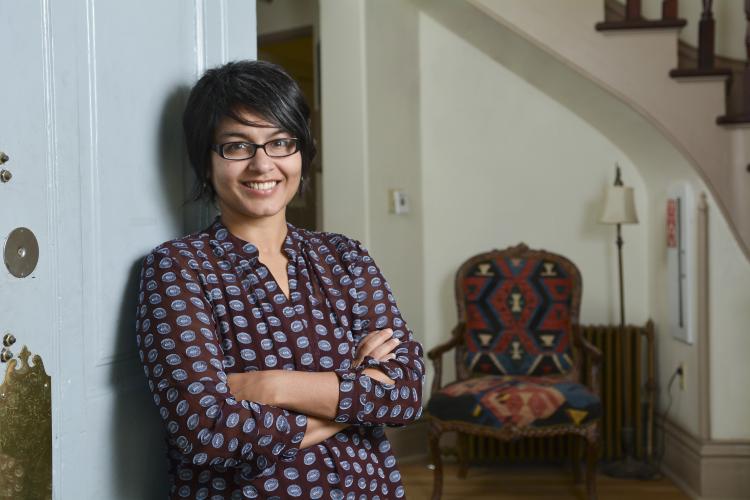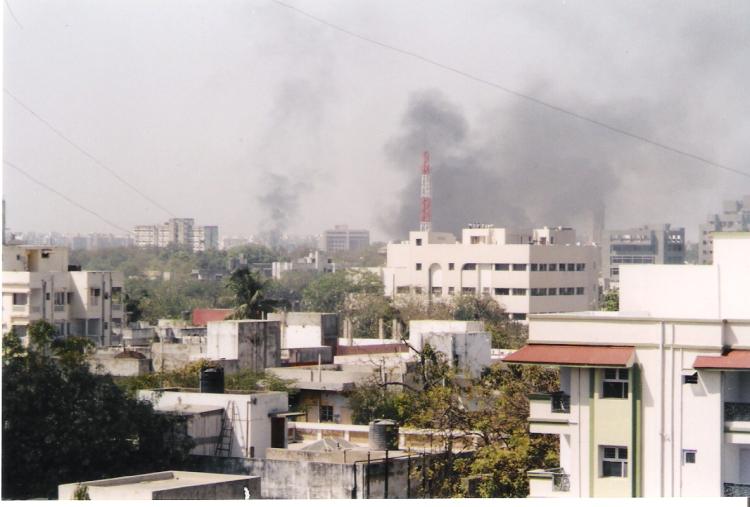The pain of partition
Scholar Deepti Misri explores gender violence in post-colonial India in Kayden Award-winning book
Just six months after the terrorist attacks of Sept. 11, 2001, as U.S. troops fought al Qaeda and the group’s Taliban protectors in Afghanistan, a brutal anti-Muslim pogrom broke out in the Indian state of Gujarat following a train fire of indeterminate cause.
The blaze took the lives of 59 people, mostly Hindu pilgrims, and the next day mobs began to destroy Muslim homes, mosques and businesses. Over several days of violence, between 800 and 2,000 Muslims and some 250 Hindus were killed, and more than 150,000 Muslims were displaced.
At least 250 Muslim women and girls were raped and burned alive, and children were forced to drink gasoline and set on fire. Some of the violence was accompanied by explicitly religious symbolism — pregnant women, for example, were slit open and shown their fetuses, impaled on weapons associated with the Hindu god Shiva.
“Some people understood the (pogrom) as mindless violence, and that was perhaps part of it,” says Deepti Misri, assistant professor of women and gender studies at the University of Colorado Boulder. “But it was also a very clear attempt to stamp the act of violence with the religious iconography of Hinduism.”
For Misri, who came to the United States in 2000 for graduate studies at the University of Illinois at Urbana-Champaign, the twin spotlights of the Gujarat pogrom and anti-Muslim sentiment that ignited in the United States illuminated a disturbing trend.
“Those two moments brought the anti-minoritarian discourse and impulse to the fore,” says Misri, who was raised in an upper-caste Hindu family in Mumbai, India. “In many ways, my work is dedicated to combating the anti-minoritarian ethos apparent in both moments.”
Partition and independence were supposed to have brought the end of colonialism. But for many of the population in India, the Indian state has become their new colonial master.”
The 1947 partition that created Muslim-majority Pakistan and Hindu-majority India following more than three-and-a-half centuries of British colonial rule sparked widespread intra-communal violence. In Beyond Partition: Gender Violence and Representation in Postcolonial India(University of Illinois Press), Misri explores different ways that violence continues to reverberate today.
“It’s really about the forms of violence associated with competing ideas of the (Indian) nation,” she says. “During the partition, one of the well-known forms of violence against women, either Hindu mobs violating Muslim women, or the reverse, was to write (religious messages) on their breasts.”
The book recently received CU’s 2016 Eugene M. Kayden Prize for literary studies. The prize committee praised Misri for shedding light “on the tragic issues surrounding both the partition of the Indian subcontinent in 1947, and continued gendered violence against men and women through the caste/religious system still vigorously operating behind the scenes in Indian culture and politics.”
The book also argues that cultural expressions of violence in media, art and entertainment don’t simply follow violence, but help mold it. Though not causal or simplistic, she says, “Violence and its representation are very intimately interlinked.”
She also argues that violent acts are themselves a kind of representation. During anti-Sikh riots in India following the assassination of Prime Minister Indira Gandhi in 1984, for example, mobs removed the turbans and sheared off the hair of Sikh men in an attack on their religion’s displays of masculinity.
Smoke rises from burning structures during 2002 riots in Ahmedabad, India, in which Hindu mobs attacked Muslims.
“What is the mob telling you there? It wasn’t just mindless violence; it had a message,” she says.
The book addresses gender-based violence toward both men and women in part, Misri says, to undermine deeply entrenched cultural notions about gender and vulnerability.
“There is often a conflation of gender with women, and gendered violence with violence against women alone,” she says. “That implicitly keeps in place the myth of the inviolability of men.”
But even gendered violence doesn’t exist in isolation; it intersects with religion, economic status, caste and other aspects of community. She points to the infamous 2012 gang rape of an educated, middle-class woman on a public bus in Delhi.
“There was a mass mobilization against rape across the country. But feminists pointed out that when Dalit (lower-caste) women are raped, that same degree of mass outrage has not been forthcoming,” she says.
Misri traveled to the Kashmir region this summer as part of her continuing research into the aftershocks of 1947. The people of Muslim-majority Kashmir were promised a referendum on their status following partition, but the vote was never held, and India still controls the region.
“Partition and independence were supposed to have brought the end of colonialism. But for many of the population in India, the Indian state has become their new colonial master,” she says.
Working with two U.S.-based Kashmiri anthropologists, Misri will conduct a workshop in Kashmir to begin recording the “sensorial” reflections of residents on their experience during the turbulent 1990s, when many Hindus fled the region.
By asking sense-based questions such as, “How did food habits shift?” and “How did the soundscape and visual landscape change?” Misri says the researchers “hope to achieve a ‘felt history’ of relationality between communities in Kashmir, adding detail to existing narratives about the shifts that occurred through the 1990s.”



